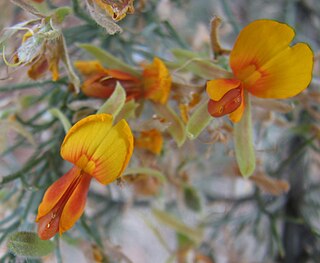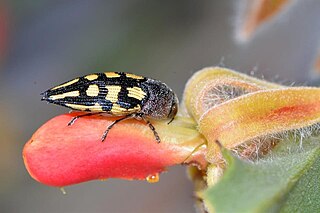Stinkwood, german Stinkholz, french Bois Puant, is the common name for a number of trees or shrubs which have wood or plant parts with an unpleasant odour, including:

Agonis is a genus in the plant family Myrtaceae. All are endemic to Western Australia, growing near the coast in the south west.

Agonis flexuosa is a species of tree that grows in the south west of Western Australia. It is easily the most common of the Agonis species, and is one of the most recognisable trees of Western Australia, being commonly grown in parks and on road verges in Perth.

Acacia rostellifera, commonly known as summer-scented wattle or skunk tree, is a coastal tree or small tree in the family Fabaceae. Endemic to Western Australia, it occurs along the west coast as far north as Kalbarri in the Southwest Australia savanna ecoregion, and along the south coast as far east as Israelite Bay.

Actinostrobus pyramidalis, commonly known as swamp cypress, Swan River cypress and King George's cypress pine, is a species of coniferous tree in the Cupressaceae. Like the other species in the genus Actinostrobus, it is endemic to southwestern Western Australia.

Adenanthos cygnorum, commonly known as common woollybush or just woollybush, is a tall shrub in the family Proteaceae. It is endemic to Western Australia, commonly occurring in the south west of the State from north of Geraldton south to Kojonup. It is very common on road verges and in disturbed areas of Perth.

Persoonia longifolia, commonly known as snottygobble, is a species of flowering plant in the family Proteaceae and is endemic to the southwest of Western Australia. It is a shrub or small tree characterised by its weeping foliage, yellow flowers and distinctive flaky bark.

Banksia aurantia, commonly known as the orange dryandra, is a shrub that is endemic to Western Australia. It has underground stems, deeply divided leaves with 18 to 28 lobes on each sides, about eighty pale orange-pink flowers in each inflorescence, and egg-shaped follicles.

Jacksonia is a genus of about forty, mostly leafless broom-like shrubs or small trees in the flowering plant family Fabaceae. The genus is endemic to Australia and species occur in a range of habitats in all Australian states except South Australia.

Jacksonia sericea, commonly known as waldjumi, is a species of low-spreading shrub or small tree that occurs in the south west of Western Australia. Found on the Swan Coastal Plain, it grows to 0.6m, has orange flowers from December to February and grows in calcareous and sandy soils. It has a Priority Four classification on the Department of Parks and Wildlife's Declared Rare and Priority Flora List.

Jacksonia sternbergiana, commonly known as stinkwood or green stinkwood, is a species of shrub or small tree that occurs in the south-west of Western Australia. It grows to between 1.5 and 5 metres high, has a weeping habit, and produces yellow and orange pea flowers in the summer. The Noongar peoples know the plant as kabbur, koorpa or mondurn.

Grevillea manglesii is a shrub which is endemic to an area around Perth in Western Australia. It usually grows to around 3 metres in height and 4 metres in width and produces white flowers throughout the year.

Daviesia triflora is a shrub in the pea family, Fabaceae, endemic to South West Australia.

Xylomelum occidentale, commonly known as the western woody pear, is a tree species in the family Proteaceae. It is endemic to Western Australia.
Grevillea phanerophlebia, commonly known as the prominent vein grevillea and the vein leaf grevillea, is a shrub of the genus Grevillea native to a small area on the west coast in the Mid West region of Western Australia.

Kensington bushland reserve is a significant remnant of Swan Coastal Plain vegetation, that has been reserved in the suburb of Kensington, in Perth, Western Australia, by the state government.

Jacksonia lehmannii is a species of leafless broom-like shrub or small tree in the family Fabaceae that is native to the south west of Western Australia. It was first described by Carl Meissner in 1844. It has no synonyms.
Jacksonia horrida is a species of leguminous plant occurring in Southwest Australia on wetter sandy soil and coastal dune systems. It bears yellow and orange to red flowers and may be prostrate or erect to a height of 2.5 metres. The distribution range extends south of Perth, occurring in higher rainfall coastal regions until reaching the west of the Esperance Plains.

Daviesia hakeoides is a spiny shrub species in the family Fabaceae. It is endemic to Western Australia. It grows to from 0.2 to 1 metre high and has yellow/orang/red/brown pea flowers, produced between May and September in the species' native range. It grows in gravelly soils, sand and granite on stony hills, sandplains and flats.

Jacksonia anthoclada is a plant in the Fabaceae family. It is endemic to Western Australia.


















